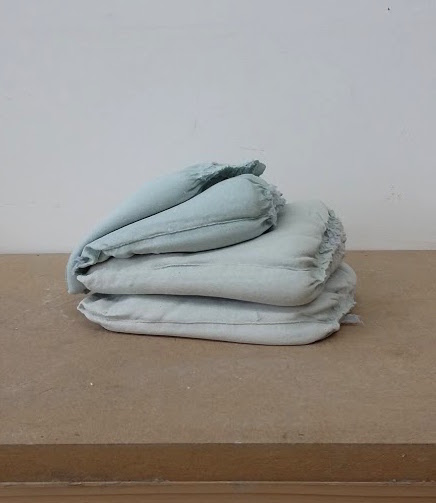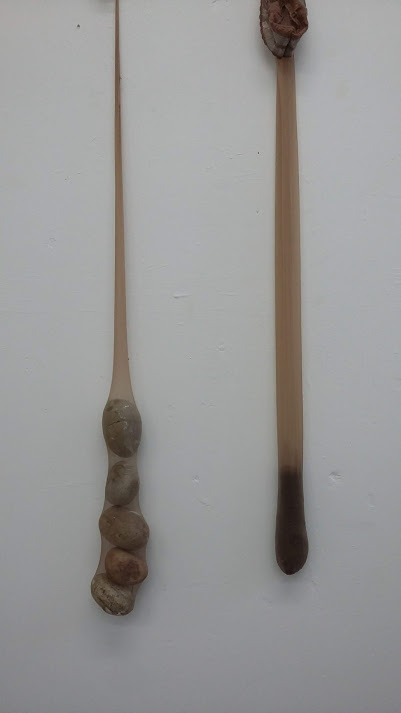The following images are taken during the exhibition Memory of Clothes at Worthing Museum from February till June 2019. The information below is copied from the gallery guide:
Memory of Clothes was supported using public funding by the National Lottery through Arts Council England.
Memory of Clothes documents research into autobiographical memory and clothing by artist Helen Barff and writer Suzanne Joinson. Their research focussed on the museum’s extensive clothing collection and memories of elderly residents at Guildcare, a local care home, during a series of workshops. Here they met Jackie, Jean, Brenda and Marion amongst others.
Suzanne Joinson developed the interviews with these ladies, as well as various other academic, scientific and creative professionals and into a series of podcasts. The podcasts be heard by following this link:
https://wtam.uk/stories/podcast/memory-of-clothes/
Untitled (eleven), 2019, jesmonite, rope, concrete, on mdf, 675 x 60 x 18 cm
Helen asked people to write a memory of clothing on a postcard, and then went round charity shops trying to find clothing that matched their description. She was drawn to the impossibility of her task, which seemed appropriate to the way memory functions, with degrees of distance, mediated or ‘lost in translation’. She cast each piece of clothing she found on a rope. The colour and pattern comes directly from the clothing. Helen has used rope before in her work, in this case it brings to mind a washing line, but also refers to story told by 97 year old Jackie about learning to swim by being cast out to sea on a rope! The rope meanders across the floor resembling a tide line and washed up objects.
Mrs Adams, ER Hammond, Brenda, Marion, 2019, cyanotype on fabric, 102 x 76 cm each
The four banners were inspired by stories told by Marion and Brenda. Both were in the Women’s Air Auxiliary Force during WW2. Brenda signed up to the WAAF and was based in barracks in Oxfordshire during the war. She met her husband there who was also in the RAF and remained so after the war. Marion drove ambulances to aircraft that had come down, navigating through the dark. She wasn’t allowed near the crash site as she might see something too upsetting for a woman.
Cyanotypes are one of the earliest forms of photography, the chemical mix being sensitive to UV light. Helen’s cyanotype banners have been cut from a used bed sheet, alluding to the body and the domestic. Cyanotypes have a particular female history, some of the most famous examples being the botanical photograms made by Anna Atkins in the mid 19th century.
Helen traced shapes directly from the WAAF uniform in the museum collection on to tracing paper, and cut them out. Then arranged these in four different compositions onto the fabric and exposed them to light.
Each composition represents a female warrior. The ladies talked about the liberation the war bought for them, but of course with rare exception, women were not allowed to pilot planes. These banners are intended to commemorate these heroic women who weren’t allowed to fly.
In contrast to a lot of the work in the exhibition, the banners are intentionally light, referring to the air, the sky and lightness in both meanings of the word. As a result of their position under the skylight, the blue of the cyanotype will change slightly during the exhibition.
Stockings (Make do and Mend) I, 2019, ink on paper, 150 x 151 cm
During WW2 the ‘Department of Information’ released a leaflet to encourage care and repair of clothing in a time of rationing as part of the ‘Make Do and Mend’ campaign. Looking closely at these prints you can spot a stitched on foot, ribbons or sections from another stocking sewn to top to lengthen it, or reinforcement on the toe and heel or where the suspender belt clips attach. Helen attempted to stitch and alter the stockings according to the ‘Make do and Mend’ instructions. Brenda and Jean told stories about wearing stockings and ‘roll on’ corsets, which compared to their mothers corsets seemed liberating.
Remy’s Hat, 2019, concrete, 27 x 27.5 x 24 cm
Nan’s Summer Hat, 2018, jesmonite 11 x 18 x 19 cm
At Remy’s wedding she wore a hat will pink netting. Helen found a similar hat in a charity shop and cast it in concrete. The animated legs and delicate netting contrast with the solid, inert helmet-like cast of a memory.
On another postcard someone wrote that their Nan had a summer and winter hat. In summer she decorated her hat with a ribbon, in winter with holly.
Stockings (Make do and Mend) II, 2019, soap, various sizes
The ‘Make Do and Mend’ booklet also refers to washing, folding and storage. One suggestion was using hand soap and used bath water to wash delicates such as stockings. By casting the insides of stockings in soap, Helen refers to gentle caressing care of the skin. Smell is known to evoke to memories. Helen chose soap brands whose smell might be familiar. For her ‘Imperial Leather’ soap immediately invokes memories of her grandmother and the cold bathroom tiles in her house. Over the duration of the exhibition the soap will curl and dry out, the smell begin to fade.
Bathers I, II, III, IV, 2019, jesmonite, plaster, steel, perspex, mdf, 168 x 122 x 72 cm
‘Bathers’ references Worthing’s location by the sea and history of bathing both in the sea and at the local Heene Baths. The heavy weight of the casts and weightlessness of the reflection sink and rise, above and below the water level surface, bringing to mind the immersive feeling of swimming. Helen was inspired by the museum’s extensive swimming costume collection and devised this piece whilst swimming. She stitched together her families old swimming costumes. She then fill them with casting material till the weight of it started to split the seams before peeling the fabric off.
Postcard series I – Stones and Potatoes
Jackie was in the Womens Land Army in Ferring. She grew and dug up vegetables, until she did her back in lifting potatoes. A picture in Vita Sackville-West’s book ‘The Women’s Land Army’ featuring heaps of potatoes reminded Helen of Jackie’s story. At the same time she collected some stones from Worthing beach. She started to draw, making connections between the two – both dug up from under the earth, a similar size and weight, a size that fits neatly into the hand. Both are shaped underground, a geological link to place.
Postcard series II – Planes
Images of planes photocopied from Brenda’s ‘Flypast’ magazine.
Postcard series IV – Memory of Clothes, please add your own memory of an item of clothing, write a note or draw a picture… By the end of the exhibition we had 400 postcards of memories. Here are a few:
With thanks to Andrew Youngson for taking the installation photographs.


































































